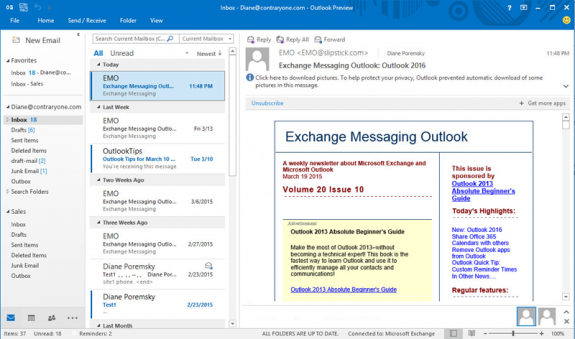

- #Microsoft office 2016 open recent menu password#
- #Microsoft office 2016 open recent menu plus#
- #Microsoft office 2016 open recent menu download#
- #Microsoft office 2016 open recent menu windows#
In the “Personalize your copy of Microsoft Office” section, click the down arrow next to Office Theme, and select Dark Gray or White (or Black) from the drop-down menu. (In Excel 2019, there’s also a black option.) To do it, select File > Options > General.

Show Tabs: This shows the tabs but hides the commands underneath them.To show the Ribbon again, click at the top of PowerPoint. Auto-hide Ribbon: This hides the entire Ribbon, both the tabs and commands underneath them.A drop-down menu appears with these three options: To get to them, click the Ribbon Display Options icon at the top right of the screen, just to the left of the icons for minimizing and maximizing PowerPoint. You’ve got other options for displaying the Ribbon as well. To make it appear again, press Ctrl-F1 and it comes back. Just as in previous versions of Excel, if you want the Ribbon to go away, press Ctrl-F1. Also see the nifty new Tell Me feature described below.
#Microsoft office 2016 open recent menu download#
To find out which commands reside on which tabs on the Ribbon, download our Excel 20 Ribbon quick reference. The Ribbon hasn’t changed a great deal from Excel 2013. But it still works in the same way, and you’ll find most of the commands in the same locations as in earlier versions. The 20 Ribbon is smaller than it was in Excel 2013, the title bar is solid green rather than white, and the text for the Ribbon tabs (File, Home, Insert and so on) is a mix of upper- and lowercase rather than all caps. If you need a refresher, see our Excel 2010 cheat sheet.Īs in Excel 2013, the Ribbon in Excel 20 has a flattened look that’s cleaner and less cluttered than in Excel 20. Since the Ribbon has been included in Office suite applications since Office 2007, we assume that by now you’re familiar with how it works. The Ribbon interface that you came to know and love (or perhaps hate) in earlier versions of Excel hasn’t changed much in Excel 2016 or 2019. Share this story: IT folks, we hope you'll pass this guide on to your users to help them learn to get the most from Excel 20. Near the end is a section for Excel 2019 only. Most of the tips in this article apply to both Excel 20 for Windows. If you or your organization has an Office 365 subscription, see our separate Excel for Office 365 cheat sheet for coverage of all the latest features.
#Microsoft office 2016 open recent menu plus#
In Office 365, Excel has all those features, plus several more.
#Microsoft office 2016 open recent menu password#
You will be prompted to provide an administrator password again, so use the same one as in step 7.This cheat sheet gets you up to speed on the features that were introduced in Excel 2016 and Excel 2019, the perpetual-license versions of Excel included with Office 2016 and Office 2019, respectively. In the folder, alt-click the program shortcut you just moved to rename it.The program shortcut will move into the folder. Type the administrator password for the computer, which for a Cedarville office is the six-digit number under the barcode sticker on the computer (not the monitor).When a window says you will need administrator permission, click “Continue.” The User Account Control window opens.From your desktop, click and drag the shortcut you created in step 1 into the open folder.Navigate to “Programs” > “Microsoft Office.”.From the pop-up menu, click “Open All Users.” A window opens.Right click “All Programs.” A pop-up menu appears.Step 2: Add desired Microsoft Office program shortcut to "All Programs" From the pop-up menu, click “Create shortcut.” A message window appears asking you if you want to place the shortcut on the desktop.The following are the specific file names for Microsoft Office programs: Find, but do not click, the desired file.Files are labeled NAME.EXE (where NAME is an abbreviation of the specific program). Navigate to “Program Files (x86)” > “Microsoft Office” > “Office16.” This folder has files for all of the Microsoft Office programs.
#Microsoft office 2016 open recent menu windows#
Under “Hard Disk Drives” (in Windows 10, "Devices and drives"), click “OSDisk (C:).”.Navigate to Windows Start Menu > “Computer” (in Windows 10, click "File Explorer" > "This PC").Step 1: Create desired Microsoft Office program shortcut Adding a Microsoft Office program shortcut back to this folder involves the following two main steps. A Microsoft Office program shortcut may sometimes be missing from the “Microsoft Office” folder of the Windows Start Menu's “All Programs” section.


 0 kommentar(er)
0 kommentar(er)
